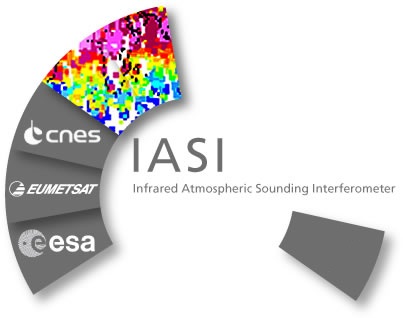
IASI

IASI, the Infrared Atmospheric Sounding Interferometer, is a key payload element of the METOP-A series of European meteorological
polar-orbit satellites launched in October 19, 2006. It is primarily designed for weather forecast and measures accurate temperature profiles in the
troposphere and lower stratosphere (accuracy 1 K (RMS) at vertical resolution of 1km in the lower troposphere), as well as moisture profiles in the
troposphere (10-15 % with 1-2 km vertical resolution). IASI will also deliver data on land-surface emissivity and sea-surface temperature
(in cloud-free conditions).
IASI is also used for atmospheric chemistry aiming at estimating and monitoring the trace gases ozone, methane, carbon monoxide, N2O
and CO2 (total column only) on a global scale. Profiles for O3, CO2
and HNO3 as well as total column CFC-11and CFC-12 are available as research products.
The atmospheric spectra are measured with 0.5 cm-1 spectral resolution and extend from 645 to 2760 cm-1.
IASI has a field of view sampled by a matrix of 2 x 2 circular pixels of 12 km footprint diameter each. The measurements are taken every 50 km at nadir
with a swath width of 2200 km and a twice a day global earth coverage.
Objectives
IASI's ability to detect and accurately measure the levels and circulation patterns of gases that are known to influence the climate will therefore significantly contribute to climate change monitoring. IASI will also deliver data on land-surface emissivity and sea-surface temperature (in cloud-free conditions).
- Stratospheric Ozone: the focus being the behavior of the "ozone hole" and mid-latitude ozone as the halogen loading of the stratosphere reaches its maximum
- Tropospheric pollution arising from industrial activity and biomass burning
- Troposphere - stratosphere exchange
- Special events such as volcanic eruptions, solar proton events, and related regional and global phenomena
Instrument
The measurement technique is based on passive IR remote sensing using an accurately calibrated Fourier Transform Spectrometer operating in the 3.7 - 15.5 µm spectral range and an associated infrared imager operating in the 10.3 - 12.5 µm spectral range. The optical configuration of the sounder is based on a Michelson interferometer. The integrated infrared imager allows the co registration of the IASI sounder with AVHRR imager on-board METOP-A.
Data Access
General Data Product Level Definition
Data is processed for distribution via
EUMETCast.
EUMETSAT is responsible for operating the instrument and the associated data processing, archiving and distribution
of the IASI data to users. The IASAI level 1c and 2 data products and services provided by EUMETSAT are made available to users via four key delivery methods:
EUMETCast, Direct Dissemination, the Global Telecommunications System (GTS)/RMDCN, and via the Internet.
A Product overview you can get here.
The MetOp-A Platform
The Meteorological Operational satellite programme (MetOp-A) is a new European undertaking providing weather data services that will be used to monitor climate and improve weather forecasts. The MetOp-A programme’s series of three satellites has been jointly established by ESA and the European Organisation for the Exploitation of Meteorological Satellites (EUMETSAT), forming the space segment of EUMETSAT's Polar System (EPS). MetOp-A has been designed to work in conjunction with the NOAA satellite system whereby the two satellites fly in complementary orbits. MetOp-A’s polar orbit is Sun synchronous, so that the satellite track along the Earth is always at the same local time, in this case in the mid-morning. NOAA will continue to operate its mid-afternoon orbit satellite service as part of the Polar Orbit Enviromental Satellites (POES) system.
The MetOp-A satellites, have been designed to embark instruments provided by NOAA, EUMETSAT, ESA and other European partners. MetOp-A will have different performances than the actual NOAA system due to a platform designed with high pointing accuracy, full on board recording capacity, digital high rate and low rate communication system, encryption capability and an increased payload.
Other Instruments on the Metop-A platform include the Advanced
Scatterometer ASCAT, the Global Ozone Monitoring Experiment
GOME-2,
the Global positioning system Receiver for Atmospheric Sounding GRAS,
the Microwave Humidity Sounder MHS,
the Advanced Microwave Temperature Sounder
AMSU, the Advanced Very High Resolution
Radiometer AVHRR.
MetOp-A’s main objectives are to furnish data for operational meteorology and climate monitoring. Many of the above instruments will give detailed information on the atmospheric temperature/humidity profiles, essential for weather forecasting.
Links
- IASI Level 1 Products Guide
- IASI Level 2 Products Guide
- MetOp-A Meteorogical Missions
- DLR Dust Retrieval
Contact
If you would like to have more information about the IASI data, please contact wdc@dlr.de.